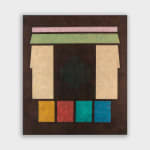

Alejandro Puente Argentina, 1933-2013
Kutral, 1989
Acrylic on canvas
182 x 160 cm
PUA0007
Experimenting with non-traditional materials enabled him to diversify his recreations: he made collages with feathers, took advantage of chipboard and cork textures, worked with incisions on wood, tied colorful threads...
Experimenting with non-traditional materials enabled him to diversify his recreations: he made collages with feathers, took advantage of chipboard and cork textures, worked with incisions on wood, tied colorful threads to create variants of quipus –as a reference to the system of strings coded by color and number of knots used by the Incas as recording devices–and painted the regularity of the module and iconographic motifs with a loose texture, as seen in Ancasti(1982) and Paicha(1988).Also at that time, pre-Hispanic architecture gained importance within his research. His temple façades, arrangements or orthogonal layouts spread in large format compositions whose titles are Mapuche, Incan and Mayan words, such as Huaraz(1997),Huacalera(1998),Uquia(1998),Tanka(2000) and Ruyala(2001). In all these works the rigidity of the constructive matrix is filtered by a weave of color created by the soft brushstroke in overlapping layers.Witness of his searches, this set of works show his continued interest in shifting the gaze to explore space and color. If by painting the edges of the frame, he had managed to shift the gaze away from the center, he got the modules and primary structures to gradually detach themselves from the bidimensional support in order to involve the viewer in a modified space and, later, the various architectures to combine and drive the gaze towards internal spaces. The early modular structures had included a chromatic highlighting of the sides, later, color was incorporated into the conceptual record of systems and, finally, it became the personal imprint of its identity. This sequence of aesthetic operations cast new light into the avant-garde assumptions of the 1940s, bearing witness to Puente’s contributions to the constructive neo-avant-garde and his active participation in the breaking points that gave rise to contemporary art.

